

9 April 2023
The Isle of Man, with its marvellous marine life, offers excellent diving. The waters are clear and nurture teeming communities of plants and animals.
The island is situated in the Irish Sea, between Britain and Ireland. It is independent with its own government. The best diving is on the South of the island, especially in the Calf of Man.
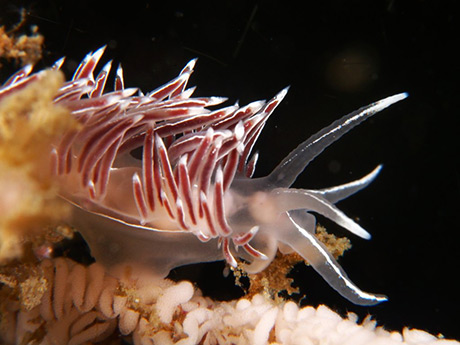
Fjordia Nudibranch taken on Garden Rock in the Isle of Man by Tim Nicholson, author of Nudibranchs and Seaslugs of the Isle of Man
With 50% of the island's waters protected, its underwater realm is beautiful. It's famous for its visiting basking sharks.
The Burroo, with its extremely diverse and plentiful marine life offers a truly magnificent dive. In fact, in areas exposed to the fast flow, it is something of a challenge to find a single square centimetre of bare bedrock, so abundant is the life here. We can only agree with the numerous experienced divers, underwater photographers and marine biologists who repeatedly acclaim it to be one of the best in the British Isles.
On the south side of the Burroo the main cliff face continues underwater into a short vertical drop and then becomes a bedrock slope. At around 15 m this provided a good, sheltered entry point. From the base of these underwater cliffs a rocky incline with intermittent large bedrock mounds and boulders runs off into depths in the 40's to the south and west. A couple of large bowl-shaped gullies, one of which is referred to as 'the amphitheatre'. Trapped at the base of one of the small underwater faces in this area was a huge timber, no doubt from a ship, and possibly part of one of the many unknown wrecks in this part of the Irish Sea.
Tidal streams off the Burroo are amongst the most severe around the Isle of Man. Strong overfalls, up currents and eddies are commonplace; this is definitely a slack water dive! As the sea plies tumultuously around the exposed rocky promontory, animals living in this current swept environment receive a deluge of suspended, planktonic organisms from the passing water. This forms an abundant food source for a dazzling multitude of 'suspension-feeding' animals that proliferate here in the gullies and on the flanks of the underwater cliff faces.
More on diving the Booroo.
With the old outer breakwater lying ruined under the water, the old T-blocks create a very sheltered bay on a low tide. This is one of the central reasons why it is where many Open Water divers take their first step on their new adventure. Port Erin's local dive, affectionately known as crab row is sheltered from most weather except W to SW winds which can unfortunately reduce the visibility.
There are two choices at this site, either enter the water at the jetty steps (near the RNLI station) and journey west out towards the old breakwater or enter at the old breakwater steps (in front of the marine biological station) and journey east.
Your max. depth will be around 12 metres and it's an easy dive for navigation. If starting from the old breakwater descend along the boulder slope and then head east. If you keep the rocks of your right and keep an eye on that compass you cannot go wrong.
One point to note is that you will need to ascend a little to clear the lifeboat slip before you continue you journey eastward towards the jetty. If you start from the small jetty take a bearing and keep the rocks on your left.
You will have a great view of Conger Eels, Wrasse including Cuckoo, Ballan and Corkwing with plenty of Tompots hiding in all those holes (so take a small touch!) The T-Blocks form loads of nooks and crannies to stick your head in in the hunt for marine life. And at night this site comes alive with squat lobsters feeding along the sea bed and if your lucky, you will sight several small bright orange octopus.

Conger Eel, Isle of Man. Photo credit: Tim Nicholson
Your main hazard at this site is boat traffic during the summer (SMB's and DSMB's are advisable). There is also a large amount of fishing line on the seabed which it is advisable not to touch due to fish hooks caught in the line just waiting to snag a passing diver! Port Erin is probably one of the Island's most commonly dived spots - especially for training as the bay area provides a safe, shallow yet interesting dive spot with incredibly easy access.
Dive write-up by Rob Bathgate, Mann Scuba Divers
The Sugarloaf Caves, situated just around the corner from Port St Mary on the Isle of Man are an excellent Dive Site for all levels. The caves are only accessible by boat, but it's just a short hop from either Port Erin or Port St Mary.
Lying behind the Sugarloaf rock itself, you have some shelter for a easy kit up and entrance, before descending down to a max depth of around 12m and journeying into the cave system. All but the end of the Cave of the Birds are actually surfacable, but the narrow and shear rock faces shut out the natural light and give an exciting dive.
After swimming between the first walls, you come out at a large junction, providing some stunning light effects as shears of sun penetrate the tiny gaps before heading through the next "cave".
Using torches, you'll see the walls covered in hydroids, sponges and anemones. With such a covering, some of the anemones, sponges and barnacles sit on top of each other, fighting for room! Soon enough you'll be heading into the deep Cave of the Birds - a common home for a few friendly seals - known to follow and play with you all the way home as you return on your path back to the boat.
Dive write-up by Rob Bathgate, Mann Scuba Divers
Peel Castle provides a fantastic back-drop for this dive, as you circle around the castle grounds, in depths touching on 10 metres. As a loop, there is no need to double back, so you can spend all the dive exploring new areas.
Starting behind the food kiosk out on the Breakwater, you can clamber in over the rocks - it gets very tricky when there is some swell, and a long way to go over the rocks at low tide, so always take this into consideration. Once you are in, it's as simple as keeping the rocks on your left all the way around.
On your way around the Castle to Fenella Beach, you'll head past a variety of backdrops, starting with a Kelp Forest, before hitting a few caves, and then around the corner to the rocky sides of the cliff face.
Peel is home to a number of Seals, which can be very playful - we've spent a whole hour with Seals playing hide-and-seek and having them nibble our fins! Just give them time to warm to you, and then they won't want to leave you alone!

Seal, Isle of Man. Photo credit: Tim Nicholson
You can easily spend an hour to navigate around the route - anything less than 45 minutes is powering it, and won't give you a chance to admire the view.
The dive can always be done in the opposite direction, starting at Fenella and exiting at the back of the Breakwater - bear in mind however, entry here is difficult - exit can be even harder. If the rocks at the breakwater are too dangerous, you can always start & finish at Fenella. Also remember that the Breakwater toilets flush straight into the sea behind the breakwater - just be careful you avoid the outlet!
The South side of Fenella Beach also provides an easy dive, just following the rocks out in a straight line. There's a number of rock channels around here which make exploring good fun.
Dive write-up by Rob Bathgate, Mann Scuba Divers
The Iron Pier runs out from Ramsey Beach, on the North of the Island, with the Dolphin (a concrete structure, not the mammal!) detached at the end, with a max depth of about 14 m at high tide.
Following along the base of the Iron Pier, in and out of the under-water structure, you'll find all loads of marine life as it all congregates under the relatively safe shelter of the pier. In case you get hungry, Crabs, Lobsters, Scallops and Queenies are a plenty!
At the end of the Pier, you can head out North for a few minutes until you hit the Dolphin - much of the structure has collapsed, which makes it a fantastic dive, with loads of nooks and crannies to poke your head under. Again, loads of marine life makes this home - with at least four resident Conger Eels, loads of Lobsters and incredibily charismatic Tompot Blennies.
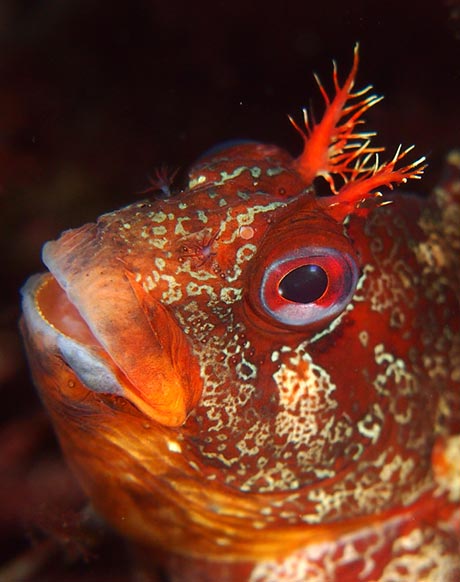
Tompot Blenny, Parablennius gattorugine, Isle of Man. Photo credit: Tim Nicholson
The Tompot Blennies, which can be seen poking their heads out of the cracks and crevices, are incredibly inquisitive fish and often pop out to take a closer look at the passing diver. It's been said that they even like the odd stroke, even appearing to become agitated when it stops!
If you're good on your air, and fancy some exercise, you can do the whole of the Iron Pier and the Dolphin in one shore dive - easy access from Ramsey Beach.
You'd have to do this shoredive at low tide, be quite fit (it's a long swim!) and give yourself at least 90 minutes for the round-trip. Alternatively you can dive it from a RIB where you can drop straight down onto the Dolphin.
The Iron Pier and the Dolphin average of around 7 m with a max of about 14 m at high tide. There can be some boat traffic around the Dolphin, so always use a surface marker and stick close to the structures when ascending. If diving from the shore, always remember it's a long swim back to the beach, so bear this and surface conditions in mind when watching your air should you have to snorkel back!
Dive write-up by Rob Bathgate, Mann Scuba Divers

The Glendun, a Belfast steamer, ran aground in 1940. She lies just south of Maughold Head, on the east coast of the Isle of Man, and is only accessible by boat (unless you're a keen rock climber!).
Lying right up close to the cliffs this dive provides some spectacular views for the journey there and for any surface intervals - which can be spent sunning yourself on the nearby private beach.
The large majority of the structure has broken up, and scattered around the area. This can turn the dive into a fun hunt, scavenge and rummage as divers shoot off in all directions looking for bits and pieces of brass glistening in the sun.
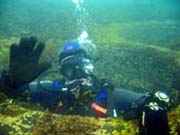
The centrepiece of this dive is the boiler; the top of which can be easily spotted from above the surface. Raising 8 metres into the water, the structure looks pretty immense when swimming right next to it. You can swim down into any one of the three boiler casings for some awesome photos, or spend your bottom time rummaging around amongst the shining brass…
With a max depth of around 12 metres, and close to the cliffs, the wreck of the Glendun is a good, easy, scenic dive. Just like a Sunday afternoon stroll.
Dive write-up by Rob Bathgate, Mann Scuba Divers
A wreck covered in plumose anemones. Can only be dived for the hour at slack water. Quite broken up but fish totally unafraid of divers.
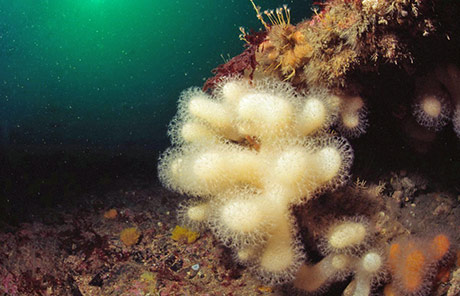
Dead Men's Fingers Anemones on the wreck of the Afton. Photo credit: Tim Nicholson
3-4 Knots of tide, anemones covering the entire bottom. You are literally flying underwater as you travel so fast.
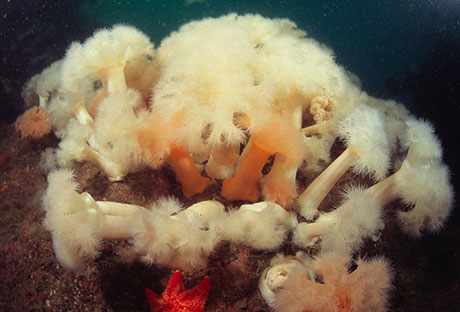
Plumose Anemones. Photo credit: Tim Nicholson
Very exposed - there is only a very limited window to dive Chickens. Mind-blowing variety with so much to see. Strong current.
It is the most southerly "island" of the Isle of Man, southwest of the Calf of Man. An old lighthouse sits atop the rock.
A maze of gullies off Langness. Seals play in the many trenches. A brilliant place for nudibranchs and sea hares sitting on ledges.
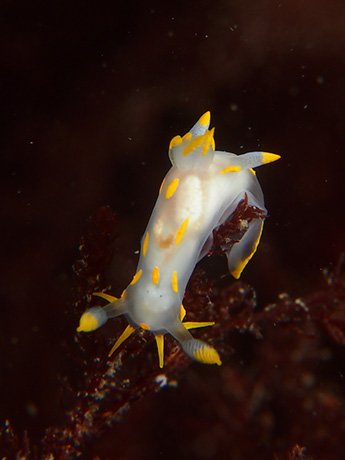
Polycera quadralineata nudibranch. Photo credit: Tim Nicholson
1Annual Cycles of Some Manx Nudibranchs, with a Discussion of the Problem of Migration. M. C. Miller, Journal of Animal Ecology Vol. 31, No. 3 (Oct., 1962), pp. 545-569
Please add your comments on diving in the Isle of Man. Do you want to recommend a dive or dive centre? Let us know.
SCUBA News is a free, monthly, publication delivered by e-mail since 2000. It contains articles on diving destinations and news of marine-life and the ocean environment.